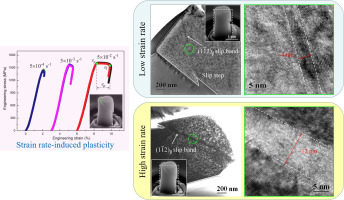当前位置:
X-MOL 学术
›
Mater. Des.
›
论文详情
Our official English website, www.x-mol.net, welcomes your feedback! (Note: you will need to create a separate account there.)
Strain rate-induced plasticity in bcc β -Ti alloy single crystal micropillars containing brittle ω -precipitates
Materials & Design ( IF 8.4 ) Pub Date : 2018-01-01 , DOI: 10.1016/j.matdes.2017.10.036 Wei Chen , Zaiwang Huang , Shuo Cao , Yan Pan , Mingda Huang , Qingmiao Hu , Ding Xu , Qiaoyan Sun , Lin Xiao , Jun Sun
Materials & Design ( IF 8.4 ) Pub Date : 2018-01-01 , DOI: 10.1016/j.matdes.2017.10.036 Wei Chen , Zaiwang Huang , Shuo Cao , Yan Pan , Mingda Huang , Qingmiao Hu , Ding Xu , Qiaoyan Sun , Lin Xiao , Jun Sun

|
Abstract Brittle ω-precipitates in bcc β-Ti alloys are well known to dramatically degrade material plasticity and even trigger macroscopic premature fracture, posing an obstacle for structural applications. The embrittlement mechanism is intimately related to dislocation pile-up at the ω/β interface that leads to stress concentration and undesirable failure. The underlying physics of improving ductility remains to be further uncovered. Here we report a new finding in β-Ti alloy single crystal micropillar compression that the plasticity can be substantially improved by means of increasing strain rate, while mechanical strength simultaneously exhibits striking “faster is stronger” fashion. The results reveal that the improvement of micropillar plasticity upon higher loading rate can be ascribed to the wider deformation band, in contrast to equivalents under quasi-static mode. The microscopic examination shows that cross slip induced by screw dislocations governs the plasticity improvement, which is further validated by crystallographic analysis and first principle energy landscape calculations. This “dynamic self-toughening” behavior advances our fundamental understanding to the plastic deformation mechanism of ω-precipitate contained bcc β-Ti alloys.
中文翻译:

含有脆性ω-沉淀物的bcc β-Ti合金单晶微柱中的应变率诱导塑性
摘要 众所周知,bcc β-Ti 合金中脆性 ω 析出物会显着降低材料的塑性,甚至引发宏观过早断裂,对结构应用构成障碍。脆化机制与 ω/β 界面处的位错堆积密切相关,导致应力集中和不良失效。提高延展性的潜在物理学仍有待进一步揭示。在这里,我们报告了 β-Ti 合金单晶微柱压缩的一个新发现,即通过增加应变速率可以显着提高塑性,同时机械强度同时表现出惊人的“越快越好”的方式。结果表明,随着加载速率的增加,微柱塑性的改善可归因于更宽的变形带,与准静态模式下的等效项相反。显微镜检查表明,螺旋位错引起的横向滑移控制了塑性的提高,这通过晶体学分析和第一原理能量景观计算得到了进一步验证。这种“动态自增韧”行为促进了我们对包含 ω-沉淀物的 bcc β-Ti 合金塑性变形机制的基本理解。
更新日期:2018-01-01
中文翻译:

含有脆性ω-沉淀物的bcc β-Ti合金单晶微柱中的应变率诱导塑性
摘要 众所周知,bcc β-Ti 合金中脆性 ω 析出物会显着降低材料的塑性,甚至引发宏观过早断裂,对结构应用构成障碍。脆化机制与 ω/β 界面处的位错堆积密切相关,导致应力集中和不良失效。提高延展性的潜在物理学仍有待进一步揭示。在这里,我们报告了 β-Ti 合金单晶微柱压缩的一个新发现,即通过增加应变速率可以显着提高塑性,同时机械强度同时表现出惊人的“越快越好”的方式。结果表明,随着加载速率的增加,微柱塑性的改善可归因于更宽的变形带,与准静态模式下的等效项相反。显微镜检查表明,螺旋位错引起的横向滑移控制了塑性的提高,这通过晶体学分析和第一原理能量景观计算得到了进一步验证。这种“动态自增韧”行为促进了我们对包含 ω-沉淀物的 bcc β-Ti 合金塑性变形机制的基本理解。



























 京公网安备 11010802027423号
京公网安备 11010802027423号